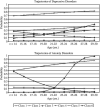Latent trajectory classes of depressive and anxiety disorders from adolescence to adulthood: descriptions of classes and associations with risk factors
- PMID: 20399331
- PMCID: PMC2857532
- DOI: 10.1016/j.comppsych.2009.07.002
Latent trajectory classes of depressive and anxiety disorders from adolescence to adulthood: descriptions of classes and associations with risk factors
Abstract
This study used person-oriented analyses to identify subgroups of individuals who exhibit different patterns of depressive and anxiety disorders over the course of adolescence and young adulthood. Using latent class growth analysis, six trajectory classes were identified. Two classes were mainly characterized by depressive disorders; one class was mainly characterized by anxiety disorders; two classes were characterized by temporally different patterns of comorbidity; and one class was characterized by the absence of psychopathology. Classes characterized largely by depressive disorders differed in persistence and degree of comorbidity with anxiety disorders. Classes that were characterized by anxiety disorders differed in persistence, age of onset, and constellation of specific anxiety disorders. Female participants were more likely to belong to classes characterized by fluctuations in the course of depressive and anxiety disorders; sex differences were not observed in classes characterized by persistent depressive and anxiety disorders. Offspring of parents with depression were more likely to have a depressive course, whereas offspring of parents with anxiety disorders tended to have a course characterized by anxiety disorder. The findings indicate that several subgroups of adolescents exist with distinct longitudinal trajectories of depressive and anxiety disorders, and these trajectory classes are associated with different risk factors.
Keywords: anxiety disorder; comorbidity; depressive disorder; longitudinal studies; transmission.
2010 Elsevier Inc. All rights reserved.
Figures

References
-
- Brady EU, Kendall PC. Comorbidity of anxiety and depression in children and adolescents. Psychological Bulletin. 1992;111:244–255. - PubMed
-
- Mineka S, Watson D, Clark LA. Comorbidity of anxiety and unipolar mood disorders. Annual Review of Psychology. 1998;49:377–412. - PubMed
-
- Kessler RC, Berglund P, Demler O, Jin R, Koretz D, Merikangas KR, Rush AJ, Walters EE, Wang PS. The epidemiology of major depressive disorder: Results from the National Comorbidity Study Replication (NCS-R) Journal of the American Medical Association. 2003;289:3095–3105. - PubMed
-
- Clark LA. Depressive and anxiety disorders: Descriptive psychopathology and differential diagnosis. In: Kendall PC, Watson D, editors. Anxiety and depression: Distinctive and overlapping features. Academic Press; NY: 1989. pp. 83–129.
-
- Alloy LB, Kelly KA, Mineka S, Clements CM. Comorbidity of anxiety and depressive disorders: A helplessness-hopelessness perspective. In: Maser JD, Cloninger RC, editors. Comorbidity of Mood and Anxiety Disorders. American Psychological Association; Washington, D.C.: 1990. pp. 499–543.
Publication types
MeSH terms
Substances
Grants and funding
LinkOut - more resources
Full Text Sources
Other Literature Sources
Medical

